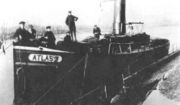.gif)
Atlas V (boat)
Encyclopedia

Context

Many Belgians sought to join the still active Belgian army. Others attempted to escape the country. For the inhabitants of Liège, this was generally done via Maastricht
Maastricht
Maastricht is situated on both sides of the Meuse river in the south-eastern part of the Netherlands, on the Belgian border and near the German border...
, in the Netherlands
Netherlands
The Netherlands is a constituent country of the Kingdom of the Netherlands, located mainly in North-West Europe and with several islands in the Caribbean. Mainland Netherlands borders the North Sea to the north and west, Belgium to the south, and Germany to the east, and shares maritime borders...
, who were neutral. The city was only 30 kilometres from the Dutch border.
Specifications
Some of the technical specifications include:- length: 23.5 metres
- width: 5.5 metres
- height: 3.5 metres
- power: 35 HP
Escape
The Atlas V arrived at about midnight, at the beginning of Coronmeuse, on the left bank in the north of the city. It was carried by the current, passing through the populated localities of HerstalHerstal
Herstal, formerly known as Heristal, or Héristal, is a municipality of Belgium. It lies in the country's Walloon Region and Province of Liege along the Meuse river. Herstal is included in the "Greater Liège" agglomeration, which counts about 600,000 inhabitants...
and Jupille
Jupille
Jupille is a former Belgian municipality. It is now a part of the city of Liège.Jupille is the location of the brewery Piedbœuf , where Jupiler is made. It is also the death place of Pepin of Herstal...
without encumberment. The boat was discovered only near Argenteau/Hermalle-under-Argenteau, and attacked by a car-boat. This sank in its wake. The Atlas V then proceeded at 45 km/h, and encountered heavy fire all along the river, lit by powerful lights. Later, the tug boat broke the railway bridge downstream of Visé
Visé
Visé is a Walloon municipality and city of Belgium, where it is located on the river Meuse, in the province of Liège.The municipality consists of the former municipalities of Visé, Lanaye, Lixhe, Richelle, Argenteau and Cheratte....
, then tore off the electrified chain and wire which barred the river. It ran into a pontoon armed with machine-guns and escaped from intense fire. It approached the right bank of the Meuse
Meuse
Meuse is a department in northeast France, named after the River Meuse.-History:Meuse is one of the original 83 departments created during the French Revolution on March 4, 1790...
at Eisden in the Netherlands (opposite Ében-Émael) around one in the morning, with the sound of Brabançonne and Belgian flag to the wind.
The boat was recovered by its owner in Liege 4 days later.
The family of Jules Hentjens, suspected of assisting in the escape, were arrested and given long prison sentences.

